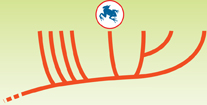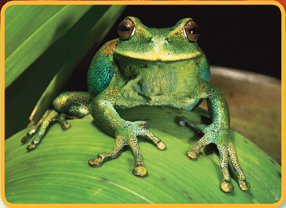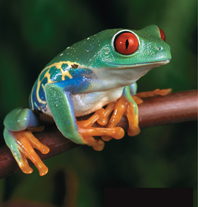Amphibians


Marsupial Frog
KEY CHARACTERISTICS
The word amphibian means “double life,” an apt name for these vertebrates, most of which live in water as larvae and on land as adults. Most adult amphibians breathe with lungs, lack scales and claws, and have moist skin that contains mucous glands.
Feeding and Digestion Tadpoles—usually filter feeders or herbivores with long, coiled intestines to digest plant material; adults—carnivores with shorter intestines for processing meat
Circulation Double-loop system with three-chambered heart
Respiration Larvae breathe through skin and gills; most adult species have lungs, though a few use gills; lungless salamanders breathe through their mouth-cavity lining and skin.
Excretion Kidneys produce urine.
Response Well-developed nervous and sensory systems; organs include protective nictitating membrane over moveable eyes, tympanic membranes, lateral line system
Movement Larvae have tails; adults have limbs (except caecilians); some have specialized toes for climbing.
Reproduction Most lay eggs without shells that are fertilized externally; most undergo metamorphosis from aquatic tadpole larvae that breathe with gills to land-dwelling adults, which usually have lungs and limbs.
Eco•Alert
The Frogs Are Disappearing!
For several decades, scientists have noticed that amphibian populations worldwide have been decreasing, and a number of species have become extinct. Scientists have not yet pinpointed a single cause for this problem. It is, however, becoming clear that amphibians are susceptible to a variety of environmental threats, including habitat loss, ozone depletion, acid rain, water pollution, fungal infections, and introduced aquatic predators.
To better understand this decline, biologists worldwide have been focusing their efforts and sharing data about amphibian populations. One amphibian-monitoring program covers all of North America.

Red-Eyed Treefrog
Table of Contents
- Formulas and Equations
- Applying Formulas and Equations
- Mean, Median, and Mode
- Estimation
- Using Measurements in Calculations
- Effects of Measurement Errors
- Accuracy
- Precision
- Comparing Accuracy and Precision
- Significant Figures
- Calculating With Significant Figures
- Scientific Notation
- Calculating With Scientific Notation
- Dimensional Analysis
- Applying Dimensional Analysis




